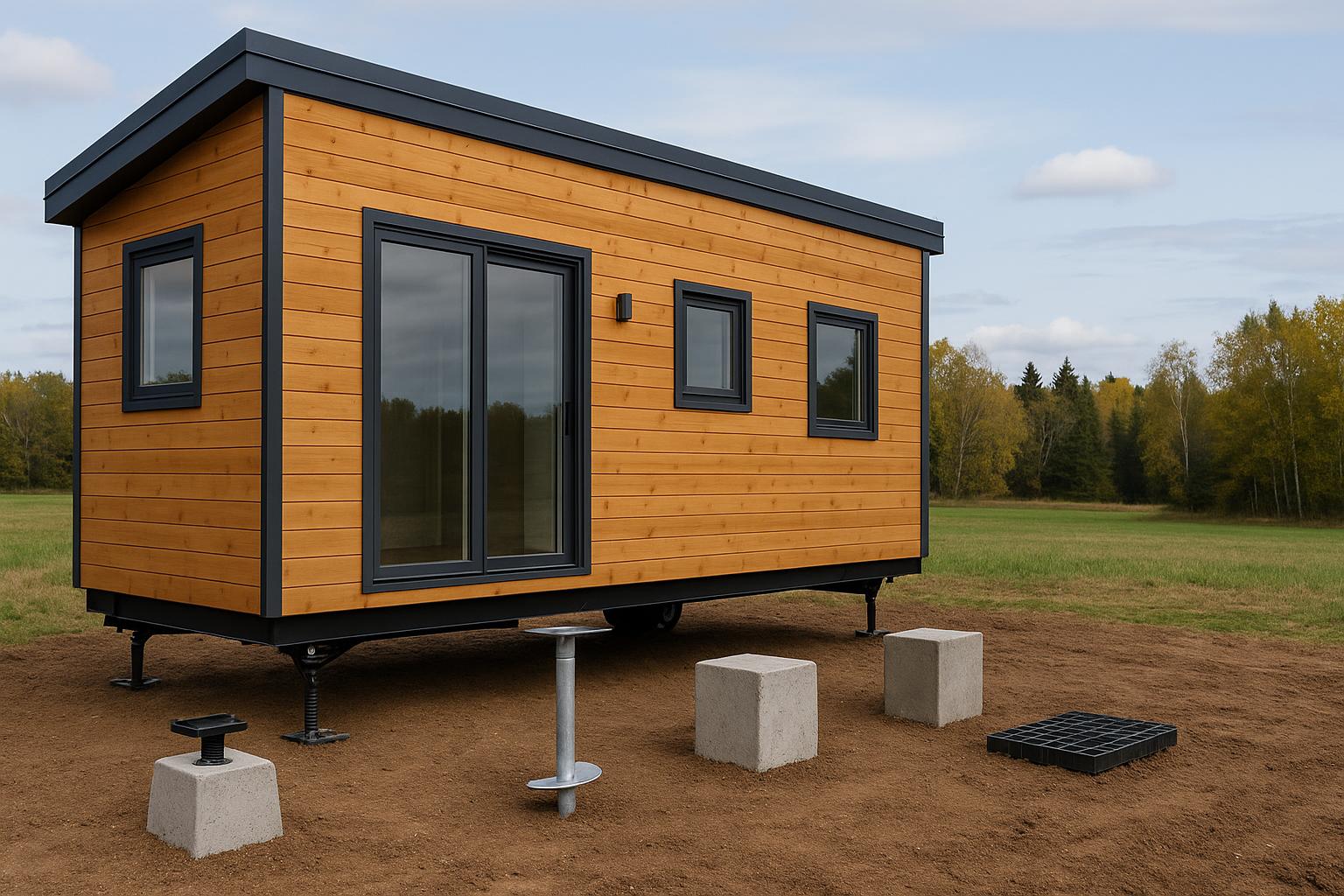
Tiny Home Foundation Options: Modern, Sustainable Choices for Canadian Soils and Climates
Estimated reading time: 5 minutes
Key Takeaways
- Modern vs. Traditional: Traditional concrete slabs and poured footings have significant drawbacks in harsh Canadian climates, while modern alternatives like screw piles and eco slab systems offer faster, more sustainable solutions.
- Sustainability: Eco slabs and screw piles reduce environmental impacts by lowering concrete use and minimizing site disruption.
- Adaptability: These modern foundations work well in various soils—from clay and sand to rocky terrains—making them ideal for diverse Canadian weather conditions.
- Regulatory Considerations: Local building codes and zoning regulations play a crucial role in foundation selection for ADUs and tiny homes.
- Future Flexibility: Screw piles not only allow quick installation but also offer reusability and adaptability for relocatable structures.
Table of contents
- Traditional Foundation Methods for Tiny Home Foundation Projects
- Modern Tiny Home Foundation Options: Screw Piles and Eco Slab Systems
- Screw Piles for Tiny Home Foundation: Fast and Sustainable in Canadian Conditions
- Eco Slab Tiny Home Foundation: Energy-Efficient and Resource-Smart
- Sustainability Considerations for Tiny Home Foundation Decisions
- ADU Construction and Tiny Home Foundation Requirements in Canada
- Comparing Tiny Home Foundation Options for Canadian Builders
- Conclusion: Making a Smart, Sustainable Tiny Home Foundation Choice
- Frequently Asked Questions
When building a tiny home or ADU (Accessory Dwelling Unit) in Canada, choosing the right foundation is one of the most crucial early decisions. Extreme cold, stubborn frost, wet springs, and unpredictable soil mean that traditional methods aren’t always the best fit. Today’s builders and homeowners are adopting innovative approaches like screw piles and eco slabs, which address the unique challenges of Canadian winters, diverse soils, and modern ADU construction.
Traditional Foundation Methods for Tiny Home Foundation Projects
For decades, concrete slabs and poured footings have served as the backbone for building foundations across Canada:
- Concrete slab: A thick, solid concrete base poured directly at grade level that provides a stable surface and anchors the structure to the ground.
- Poured footings: Concrete pads or continuous trenches set beneath load-bearing parts of a building, often combined with posts or walls to transfer weight deeper into the soil.
Drawbacks: High cost and labor intensity, slow curing times in cold weather, a larger carbon footprint due to heavy raw material use, and unnecessary site disruption—making them overkill for the smaller structures of tiny homes and ADUs.
Supporting research can be found at The Tiny House Foundation and Wild Abundance.
Modern Tiny Home Foundation Options: Screw Piles and Eco Slab Systems
Modern solutions have emerged to better suit Canada’s environmental and structural challenges:
- Screw piles: Steel helical supports that are twisted into the soil, providing strong anchorage without extensive excavation or concrete work.
- Eco slab systems: Engineered concrete slabs made with recycled materials, integrated insulation, and reduced carbon footprint.
These innovative options not only decrease installation time and environmental impact, but they also adapt to a wide range of soil types, from clay and sand to rocky terrains. For more details, visit Adustart Tiny Home Living Guide and Wild Abundance.
Screw Piles for Tiny Home Foundation: Fast and Sustainable in Canadian Conditions
What Are Screw Piles?
Screw piles are galvanized steel shafts with helical blades—essentially a giant screw—driven deep into the soil. They form secure supports for tiny homes, ADUs, or cabins.
How They Work:
- Quick installation: Using hydraulic machinery, screw piles are driven into the ground with minimal disruption.
- Year-round suitability: They can be installed even in severe Canadian winters, including periods of deep freeze.
- Reusability: These piles can be unscrewed and relocated if the tiny home needs to move.
- Wide compatibility: Effective in clay, sand, rock, and unstable soils due to their deep anchoring beneath the frost line.
Key benefits include minimal site disturbance, rapid installation, and sustainable building practices by reducing material usage. Learn more at Adustart Moving Tiny Home Canada.
Eco Slab Tiny Home Foundation: Energy-Efficient and Resource-Smart
What Are Eco Slabs?
Eco slab foundations are engineered concrete slabs that incorporate recycled materials, integrated insulation, and optimized design for lightweight construction—making them perfect for tiny home projects.
Advantages over regular slabs:
- Lower embodied carbon: Utilizing recycled content, such as fly ash or slag, to partially replace cement.
- Superior insulation: Integrated thermal breaks reduce heat loss, which is crucial during Canadian winters.
- Resource efficiency: Less new cement and reduced construction waste lead to a smaller environmental footprint.
For additional insights, see Adustart Energy Efficiency Tiny Homes Canada.
Sustainability Considerations for Tiny Home Foundation Decisions
Selecting the right foundation not only affects structural integrity and cost but also plays a major role in sustainability:
- Modern foundations like eco slabs and screw piles reduce the use of concrete and minimize excavation, lowering greenhouse gas emissions.
- They generate less construction waste by using only essential materials and through modular or reusable designs.
- Long-term savings are realized via lower heating bills and reduced maintenance costs due to enhanced durability against freeze–thaw damage.
- The reusability of screw piles and the efficiency of eco slabs support environmentally responsible building practices.
Further reading is available at Adustart Tiny Sustainable Living Homes and Wild Abundance.
ADU Construction and Tiny Home Foundation Requirements in Canada
What is ADU Construction?
An Accessory Dwelling Unit (ADU) is a secondary, self-contained residence—such as a backyard suite or garden suite—built on a foundation that meets necessary stability, speed, and code compliance requirements.
Foundation Needs for ADUs and Tiny Homes
- Rapid installation: Quick foundation solutions are essential given tight construction windows and unpredictable weather.
- Adaptability: Sites with uneven, compact, or rocky terrain require foundations that can adjust to varied conditions.
- Sustainability and compliance: Environmental considerations and local building codes drive the selection of foundation systems. More details can be found at Tea Cup Tiny Homes FAQs and Adustart Ontario ADU Zoning Guide.
Understanding both the technical and regulatory aspects is essential when planning your tiny home or ADU foundation.
Comparing Tiny Home Foundation Options for Canadian Builders
Below is a direct comparison of traditional and modern foundation methods:
| Foundation Type | Cost | Sustainability | Installation Speed | Soil/Climate Suitability | Durability |
|---|---|---|---|---|---|
| Concrete Slab | High | Low – high material use | Slow (requires curing time, especially in cold) | Suitable mainly for level, stable soils; vulnerable to frost heave | High but not easily modified or moved |
| Screw Piles | Moderate | High – minimal waste & site impact | Very Fast (often completed in hours) | Adapts to nearly all soils; excellent frost resistance | High and reusable |
| Eco Slab | Moderate | High – reduced embodied carbon with superior insulation | Moderate | Excellent in most soils with outstanding thermal properties | High |
How to Decide: Consider factors such as soil and climate, site access, budget, building mobility, local building laws, and sustainability priorities when choosing your foundation system.
Conclusion: Making a Smart, Sustainable Tiny Home Foundation Choice
Choosing the best foundation for your tiny home in Canada involves balancing durability, cost, installation speed, local soil conditions, and sustainability. Screw piles offer fast and flexible options for relocatable structures, while eco slabs deliver excellent insulation and energy efficiency with a lower environmental impact.
Before breaking ground, always consult with professional builders or engineers who understand the unique challenges of your location to tailor your foundation choice for long-term success.
For further details and guidance, visit Tea Cup Tiny Homes on Foundations Canada, Tiny Houses on Foundations FAQs, and Tiny House Plans Guides.
Frequently Asked Questions
Q1: What factors should I consider when choosing a foundation for my tiny home?
A: Consider local soil conditions, climate factors such as frost, budget constraints, installation speed, and sustainability goals. Both screw piles and eco slabs offer benefits tailored to the Canadian environment.
Q2: Are screw piles suitable for all types of soil?
A: Yes, screw piles are designed to adapt to various soil types, including clay, sand, and rocky ground. Their deep anchoring provides reliable support even in challenging conditions.
Q3: How do eco slabs help reduce energy costs?
A: Eco slabs incorporate integrated insulation which helps maintain indoor temperatures by reducing heat loss to the ground, thus lowering heating bills during cold Canadian winters.
Q4: Do local building codes affect my foundation choice?
A: Absolutely. Building codes and zoning regulations vary by region, so it’s important to consult local authorities or professionals to ensure your chosen foundation complies with all requirements.

Leave a Reply